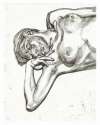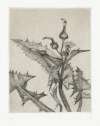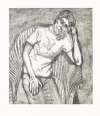 Eli © Lucian Freud 2002
Eli © Lucian Freud 2002
Lucian Freud
57 works
Key Takeaways
Lucian Freud's print market demonstrates robust year-on-year growth, with individual etchings commonly achieving anything from £20,000 to £125,000, while exceptional pieces can surpass £150,000. Authentication demands thorough analysis of paper characteristics, printing methods, and ownership history, with the Toby Treves and Sebastian Smee catalogue raisonné serving as an essential resource. Freud's numbering system, often rendered incomplete, and signature are crucial for confirming genuineness. Given Freud's renowned attention to intricate details and textures, the print's condition significantly influences its worth, with immaculate examples commanding top prices. Timing sales to coincide with major exhibitions, artist milestones, or notable painting auctions can maximise returns.
Lucian Freud, grandson of psychoanalyst Sigmund Freud, emerged as one of the most influential figurative painters of the 20th century. While primarily known for his paintings, Freud's etchings have become increasingly sought after by collectors, offering a unique insight into his artistic process and vision. This guide aims to navigate the complex market for Freud's prints, providing crucial information on valuation, authentication, and optimal selling strategies.
Born in Berlin in 1922 and later settling in London, Freud's artistic career spanned over seven decades, during which he developed a distinctive style characterised by thick, textural brushwork and an unflinching approach to portraiture and the human form. Freud's method of printmaking was as meticulous and intense as his painting practice. He began creating etchings in the 1940s but returned to the medium with renewed vigour in the 1980s, producing some of his most celebrated printed works. His etchings often mirror the subjects of his paintings, featuring intimate portraits of friends, family, and fellow artists, as well as his iconic nude studies. Freud's prints are notable for their raw, expressive lines and deep psychological insight, and are popular with collectors looking to capture something of Freud’s artistic power and intensity for a more accessible price point.
How Much Do Lucian Freud Prints Sell For?
The value of Lucian Freud’s prints continues to rise, with a 10% AAGR in the last 5 years. Some of Freud’s most popular, or previously undervalued, prints have experienced much higher AAGR - Thistle (1985), for example, has seen 42% in recent years. This appreciation of value began in the artist’s lifetime, but his death in 2011 catalysed value growth.
Prices can, however, vary widely based on factors such as rarity, condition, subject matter, and the specific period of Freud's career. Early prints from the 1940s and 1950s, while less characteristic of his later style, are highly prized for their rarity and historical significance. Freud's most sought-after prints tend to be his large-scale etchings from the 1980s and 1990s, particularly those featuring notable sitters or exemplifying his preoccupation with the human form. For instance, David Dawson (1998) an etching of Freud’s own studio assistant, sold for £180,655 at Christie's New York in 2018, over 10 times its high estimate, setting a record for a Freud print at auction. It is important to note that this print was sold out of the Collection of David and Peggy Rockefeller. More recently, in 2023, Eli (2002) (an etching of one of Freud’s whippets) and Kai (1991-92) both achieved over £60,000, demonstrating the continued strength of the market for exceptional examples of Freud's printmaking. Eli (2002) is a regular high-performer at auction, with other prints selling for between £70,000 and £125,000 in the past 10 years. Other sought-after prints include Pluto (1988) (another of Freud’s whippets) and Woman With An Arm Tattoo (1996).
Individual prints from Freud's more common editions typically fetch between £20,000 and £60,000. Complete portfolios of Freud's prints are extremely rare on the market but can achieve substantial sums when they do appear. Freud's market has shown steady growth over the past two decades, with particular spikes following major retrospectives or significant sales of his paintings. For example, following the record-breaking sale of his painting Large Interior, W11 (After Watteau) (1981-83) for £65million in 2022, there was a notable increase in interest and value for his prints.
How Do You Authenticate a Lucian Freud Print?
Authenticating a Lucian Freud print requires a comprehensive approach, combining provenance research, technical analysis, and expert evaluation. Key factors include paper quality, printing technique, and the presence of Freud's distinctive signature and edition numbering. Freud worked primarily with a small number of master printers, most notably Marc Balakjian at Studio Prints in London. Understanding the specific characteristics of prints produced at these workshops, particularly the printer’s marks, can be crucial for authentication. Freud was known for his meticulous approach to printmaking, often working directly on the plates and overseeing the printing process, which resulted in prints of exceptional quality and consistency.
In order to prove the authenticity of your print, you will also need a full history of documentation, including past sales, exhibition history, and a certificate of authenticity from the print’s creation. For definitive authentication, it's advisable to consult with recognised Freud experts or reputable auction houses specialising in modern British art. The Lucian Freud Archive, managed by the artist's estate, can also provide valuable assistance in verifying works.
Catalogue Raisonné
The definitive catalogue raisonné for Lucian Freud's prints is Lucian Freud: Catalogue Raisonné of the Prints by Toby Treves and Sebastian Smee, published in 2022 by Modern Art Press. This comprehensive volume documents all of Freud's known prints, providing essential details on editions, dates, and provenance.
Edition and Signature
Freud’s signature typically appears in pencil on the lower right of the print, often accompanied by the date of creation. Freud's signature is distinctive, typically featuring a flowing “L” followed by a more angular “Freud,” or as a simple “L.F”. Edition numbers are usually found on the lower left, written as a fraction (e.g., 15/40). Freud's print editions were often small, ranging from 20 to 50, with some special editions being even more limited. Artist's proofs, usually marked “A/P,”, are particularly valued by collectors. Freud was known to be very particular about the quality of his prints, often destroying impressions that didn't meet his standards. As a result, some editions may have fewer prints than originally intended, increasing their rarity and value.
Browse Lucian Freud prints on the Trading Floor and find out more about the print market growth on the MAB100 Print Index.
Looking to Sell Your Lucian Freud Prints?
Request a free and zero obligation valuation with our team without hesitation. Track your prints & editions with MyPortfolio.
Has Your Lucian Freud Print Been Kept in Good Condition?
Given Freud’s focus on texture and detail, even minor damage can significantly impact the overall effect and value of your print. When assessing a Freud print, consider the following factors. Look for any discolouration, foxing, or acid burn. Freud often used high-quality, handmade papers, and their preservation is key to maintaining value. Freud's etchings are known for their sharp, precise lines - any blurring or fading can signify water damage or exposure to direct sunlight and detract from the print's value. Untrimmed margins often indicate a well-preserved print and can enhance value. Check for any creases, tears, or handling marks around the edges. Surface Imperfections should be carefully examined.
Proper storage and display are essential for maintaining any print's condition. Ideally, prints should be kept flat, in acid-free folders, away from direct sunlight and fluctuating humidity. If framed, UV-protective glass and acid-free matting are essential. It's worth noting that some of Freud's prints, particularly those from the 1940s and 1950s, may show signs of age that are consistent with their period; in these cases, acceptable wear and tear may be considered part of their historical value. However, any damage occurring after the initial printing should be carefully assessed. For a thorough assessment, consider consulting a paper conservator specialising in contemporary prints. They can provide a detailed condition report and advise on any necessary conservation measures. For advice on how to get started, contact MyArtBroker.
When is the Best Time to Sell My Lucian Freud Print?
Timing the sale of a Lucian Freud print requires careful consideration of market trends and external factors. The contemporary art market can be cyclical, with periods of heightened interest in certain artists or movements. For Freud's work, several factors can influence optimal selling times. Retrospectives and major exhibitions often spark renewed interest in an artist's work. For example, the Royal Academy of Arts' 2019 exhibition Lucian Freud: The Self-portraits led to increased attention and sales activity for Freud's prints, as did the Lucian Freud: New Perspectives exhibition at the National Gallery from 2022 to 2023.
Significant anniversaries in Freud’s life and career can also catch the attention of collectors, galleries, and the media. The centenary of Freud's birth in 2022 saw numerous celebratory events and publications, potentially boosting market interest. You should also keep an eye on the broader market for post-war British art, as strong sales in this category can positively impact Freud's market. High-profile sales of Freud's paintings can generate spillover interest in his prints. We recommend monitoring auction results across all mediums to identify peaks and troughs in value and demand - most of the major auction houses publish regular value trajectory reports on their websites.
MyArtBroker offers advanced art tech tools to help you determine the optimal time to sell. Our MyPortfolio service features an AI-powered value indicator that provides real-time valuations of individual prints based on both public and private sales data. Combined with our complimentary valuations, we can help ensure your print achieves maximum value by selling at the perfect moment.
Ways to Sell with MyArtBroker
At MyArtBroker, our specialists provide a free market valuation for your artwork, offering a level of transparency unmatched in today’s market. In addition to our valuations, through our online Trading Floor, you can access real-time insights into works by the artist you’re looking to sell, including pieces that are most in demand, wanted, or currently for sale: allowing sellers to trust the valuation that they are provided.
Additionally, the MyPortfolio collection management service grants you free access to our comprehensive print market database. This resource allows you to review auction histories for the specific work you’re looking to sell, including hammer prices, values paid, and seller returns. In a fluctuating market, this historical data is invaluable - and often comes at a cost elsewhere - offering insights into past and current values to further inform decisions based on market timing and conditions. In addition to our specialists guidance, you have concrete data.
Our approach is tailored to align with the unique attributes of each artwork, and offer optimal results:
How a Private Sale Works
Unlike peer-to-peer platforms, which lack specialised expertise, authenticity guarantees, and legal infrastructure for high-value sales, MyArtBroker operates through private sales ensuring a secure and seamless transaction process. We charge sellers 0% to sell, and take a small commission from our buyers, absorbing essential aspects including insurance, shipping, and marketing - at no extra cost to the seller. There is no magic to it, we’re a lean specialised business with less overheads than traditional models meaning we can do better for our clients.
Our revenue is derived from buyer commissions only, which are individually negotiated upon offer, and we aim to give the client the best return in the market place. By focusing on high-value artworks in excess of £10,000, we provide specialised care and expertise, ensuring each piece receives the attention it deserves, while simultaneously maximising returns with our clients. For works that fall below this threshold speak to the team about a recommendation, we offer market advisory free of charge. Our goal at MyArtBroker is to offer a seamless solution, setting us apart in the art market.
Advisory and Recommendations
In cases for artists and artworks, where our existing network of collectors isn’t the best fit due to value, medium or condition we collaborate with reputable partners to facilitate its sale. Carefully tailoring your artwork to the right party. This tailored approach is especially important as it considers the unique attributes of each artwork, providing sellers with the best possible outcome in today’s shifting art market. You can discuss this approach with us without charge as part of our advisory service.
Such recommendations are on a case-by-case basis, and ensures broader exposure and takes advantage of our knowledge of where a work will do best.
Lucian Freud Collection Management with MyPortfolio
In addition to our live trading floor, MyArtBroker's MyPortfolio serves as a collection management system, empowering collectors to curate and oversee their prints and editions collection. This feature grants users access to our print market database, uniquely tied to our proprietary algorithm, SingularityX. This algorithm scans and analyses both public auction and private sales data to determine real time valuations of individual print works, factoring in various aspects such as condition, colour, and other factors affecting value.
Read What Powers MyArtBroker's Technology? In Conversation With Stuart Jamieson, Financial Quant to learn more about our algorithm.
Emerging art tech tools are vital in navigating the current, and evolving, digital art market landscape. For instance, by adding Lucian Freud prints from our website to the MyPortfolio dashboard, users gain insight into unique sale opportunities and observe market performance and fluctuations as they happen, streamlining the sales process effortlessly. Our pioneering technology has revolutionised art portfolio management, making it more accessible and equipping users with data-driven insights for informed decisions. MyArtBroker harnesses cutting-edge technology driven by data, coupled with a team of industry experts, to deliver an exceptional experience. Our professionals work closely with clients, utilising the MyPortfolio dashboard, to provide personalised guidance for creating a profitable art collection. By merging technology and expertise, we are committed to offering unparalleled curation and customer service.














